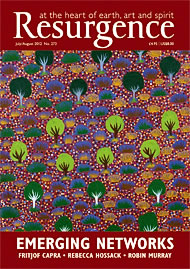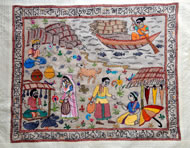The countless poems and songs composed by Rabindranath Tagore fanned the flames of a huge cultural renaissance in Bengal at the start of the 20th century, just as Western culture began driving itself so purposefully in the opposite direction. Tagore could see what was happening and sought to warn the world. Consider his observation made in 1916 as he watched the ever-growing enthusiasm for a world of convenience. “There is an aggressive force of greed linked to a science that is smothering all time and space over the Earth. All that is human is being broken down into fragments,” he warned.
Tagore’s response to this danger was to celebrate and lay great store by the traditional crafts that were still very much alive in his homeland. He could see that, sooner or later, what was being abandoned would once again be needed and treasured. One of these traditional crafts provided an inspiring exhibition at the Nehru Centre in London in March this year. The pieces in this show were contemporary rather than from Tagore’s day, but they all drew inspiration from his work.
The craft is called Kantha, a type of traditional embroidery, popular in Bangladesh and West Bengal in Tagore’s time, that has since enjoyed a more modern revival, courtesy of the woman who created this exhibition, Shamlu Dudeja. Her enthusiasm has led to Kantha recently adorning the world of designer fashion wear, but this exhibition was concerned with more traditional pieces of work.
Like so many forms of craft revered today as high art, Kantha began life not on the walls of expensive art galleries, but in domestic service. It was simply part of the necessary process of making do and mending. It depends upon a kind of running stitch, once used in Bengal for mending and reinforcing old clothes. The strands of colour came originally from the borders of old saris. I was rather struck by the fact that, despite this show being in the heart of London’s Mayfair and displaying the work of evidently highly skilled hands, the pieces themselves retained a sense of this humble origin. They had a simple and direct impact and I am sure this would have pleased Tagore. It is certainly what attracted the ever-dynamic Dudeja.
She is chair of the Calcutta Foundation, which has worked tirelessly to create schools and education projects for some of the most desperate in Bengali society. She chanced upon a group of women at a trade fair in Calcutta and was intrigued by the beautiful wall hangings they were selling. She invited them home and asked them to embroider her some saris using this intriguing stitching technique, and that was the start of her Kantha Collection, which she has been selling successfully ever since from her shop in the bustling city.
It wasn’t so much the business opportunity that inspired her. It was what this art form meant to the women of rural Bengal. As she put it, “From that moment I lived to promote it and the women behind it.” She has since founded several charitable organisations dedicated to teaching Kantha to the women of rural villages so that they, too, can earn a living from what has become, through her enthusiasm for it, a popular mode of design. All of the pieces of Kantha in the London exhibition were created by women Dudeja had challenged to embroider scenes from some of Tagore’s well-known short stories, poems and dramas.
Thus, for instance, one woman found inspiration in the series of language primers by Tagore that have been used in schools to teach generations of Bengalis. The Kantha designs portrayed scenes from the typical daily life of a child. I particularly liked the panels that depicted key scenes from Tagore’s play about the daughter of the King of Manipur, Chitrāngadā, who was brought up as a son. Her father taught her warcraft, politics and archery until she was spotted by the hero, Arjuna, who fell in love with her.
One panel of Kantha shows Arjuna’s recognition awakening Chitrāngadā as a woman. There is real emotion in the girl’s eyes, but also in her pleaful gesture, for Arjuna has fallen in love with what he himself has created, a transformed woman, whereas Chitrāngadā wants him to love her as her true self. The simple depiction of her longing for truth reminded me of an observation by Tagore: “For us the highest purpose of this world is not merely living in it, knowing it and making use of it, but realising our own selves in it through the expansion of sympathy; not alienating ourselves from it and dominating it, but comprehending and uniting it with ourselves in perfect union.”
That higher purpose can, surely, only be attained by a mind attuned to subtlety, and this was the overriding message for me of this short show. We are apt to forget that the great difference between a traditional craft and that which is produced by modern industrial processes is the degree of wisdom it reveals. In traditional crafts the tools never become complicated or sophisticated. For all of the wonders they help us produce, they remain basic and very simple. Our modern, sophisticated machines and computers are quite the reverse. All we do is press a button or click a mouse and, as a consequence, we do not grow. Only through the daily practice of a craft do we deepen our experience and gain that perception we call wisdom, a perspective gained purely through practical action and the honing of one’s skill. In this way craftsmanship is nothing less than prayer in practice. As we work on the outward material, so we work also on the quality of our heart. The external tools are simple; the sophistication lies within.
Little wonder, then, that Tagore was a keen collector of folk art, including pieces of Kantha. It formed the bedrock of his outlook. “A civilization remains healthy and strong as long as it contains in its centre some creative ideal that binds its members in a rhythm of relationship. It is a relationship which is beautiful and not merely utilitarian.”
That combination of the utilitarian and the beautiful, and the transformative effect of the crafts, stood in blunt contrast to the scene that greeted me back out on the busy streets of Mayfair. Nearly every person I looked at was plugged into their mobile phone, distracted by the virtual and wholly informational world of the internet. Remarkable though they are, these machines do not increase our sensitivity to the real world and I do not think it too fanciful to suggest that if we were to spend just a little less time poking them and turn our attention a bit more to the simple pleasure of the making of things with our hands, then we might find a little more balance in our own lives.
The careful practice of a simple craft, seeking beauty as we perform a utilitarian task, is an occupation that carries little or no currency in our fast-moving, convenient world. And yet, how quickly might we re-earth ourselves if we turned again to the production of the handmade? Not as a means of earning a living – I am not that idealistic – but simply as a practical means of stilling our distracted attention for a while and thus rearticulating a long-abandoned prayer to creation.








